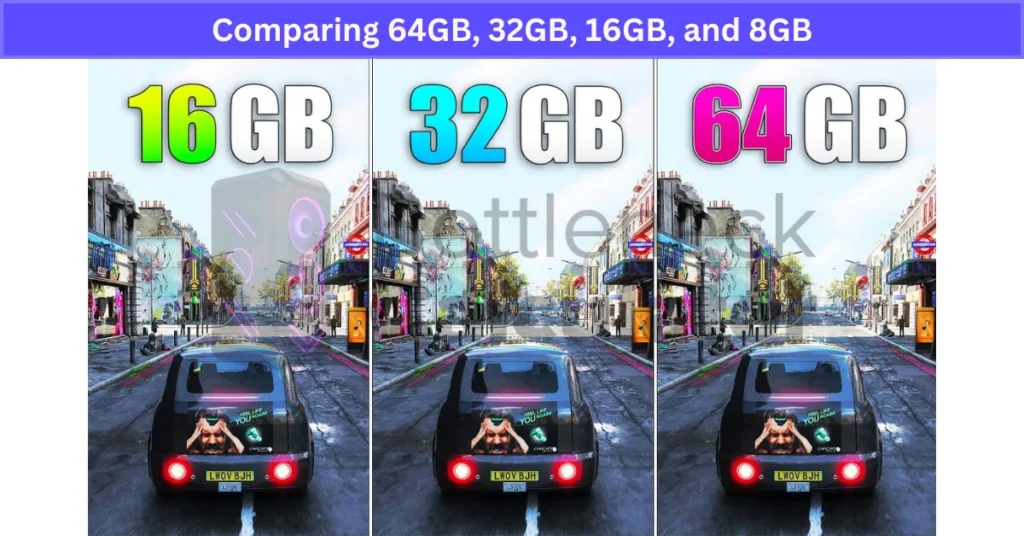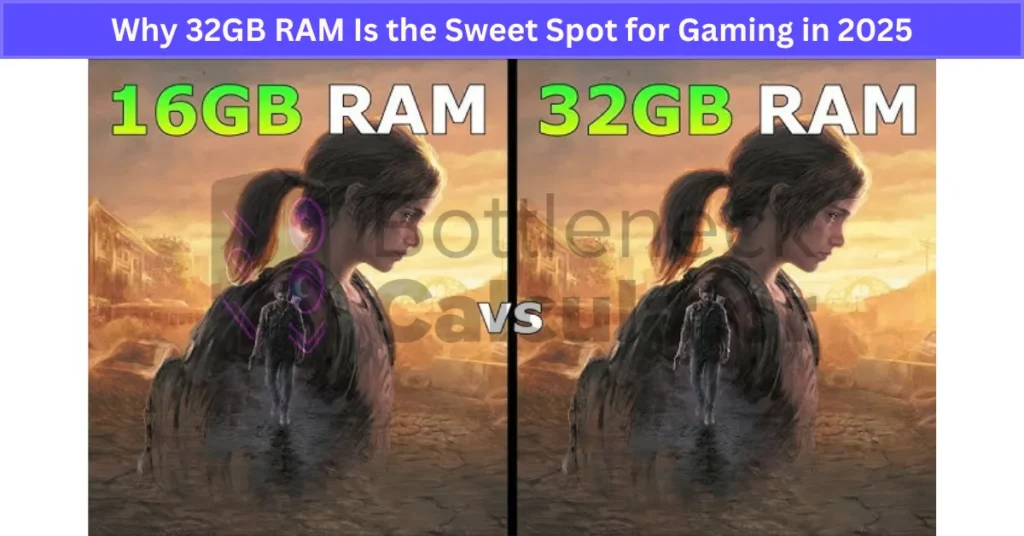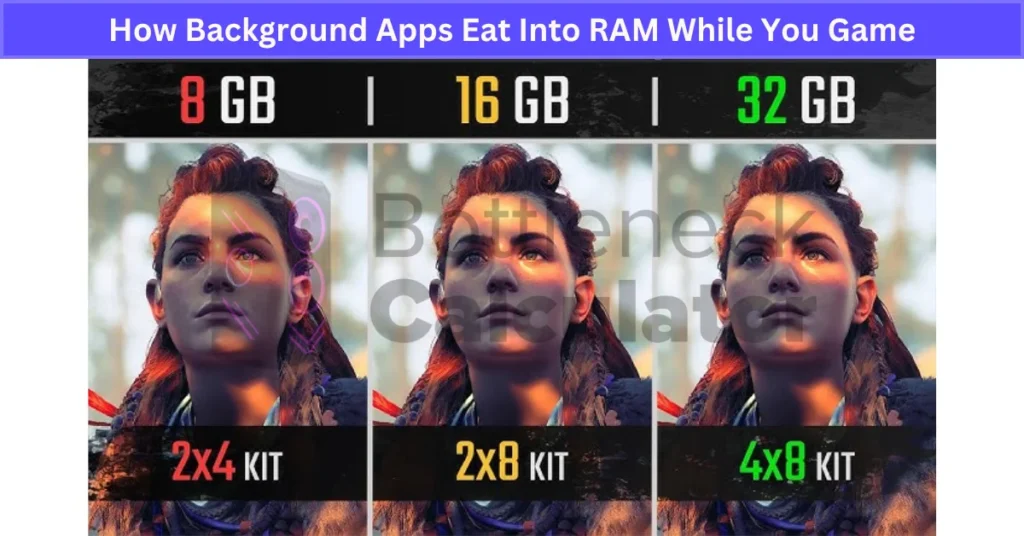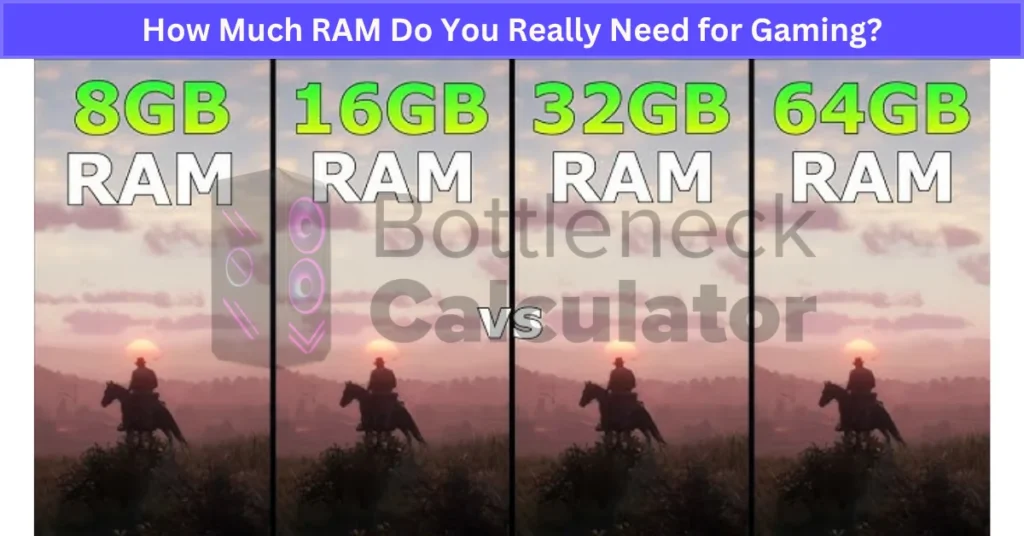How Much RAM Gamers Need in 2025? 16GB vs 32GB vs 64GB
Last updated:
I’ve seen this question come up a lot: how much RAM Gamers Need nowadays? It’s not as simple as saying “16GB is enough” or “you need 64GB.” RAM usage in modern games changes a lot depending on the game, background apps, and your system setup. Plus, testing real games often shows different results than synthetic benchmarks. If you don’t have enough, a RAM bottleneck can easily slow down performance, even with a powerful CPU and GPU.
16GB RAM for Gaming
16GB still works fine for many gamers. Most modern games will run okay on 16GB DDR5 RAM for gaming. According to tests in dozens of popular AAA games, your system will use about 4.5GB just idling, but games can push total RAM use close to 16GB. That means 16GB covers most needs if you’re just playing and not running many apps in the background.
The catch is when you start multitasking — like streaming, running chat apps, or heavy browser tabs. Then 16GB can hit limits and cause stutters or slowdowns. Also, some newer AAA titles already use close to or above 16GB, especially with high settings.
32GB RAM: The New Sweet Spot
I’d say 32GB is the best RAM size for gaming for most people in 2025. It lets you game with high fidelity settings and keep background apps running smoothly. Whether you stream, game, or have many apps open, 32GB keeps your system from bottlenecking on memory.
Tests show many games rarely push above 20–25GB total system RAM use, so 32GB gives you plenty of breathing room. Plus, dual-channel, dual-rank setups (like 2x16GB or 4x8GB modules) can improve performance over single-rank sticks, especially on DDR5 RAM for gaming.
What About 64GB RAM?
Honestly, 64GB is mostly for power users. If you stream, do video editing, 3D work, or run heavy software alongside gaming, then 64GB might make sense. Otherwise, it’s overkill and won’t boost your gaming much.
In tests, 64GB doesn’t show big gains in pure gaming performance. The extra RAM mostly helps with multitasking and future-proofing. So if you want to keep your setup ready for years or use demanding apps, go for 64GB.
Real RAM Usage in 39+ Games: Comparing 64GB, 32GB, 16GB, and 8GB
I’ve noticed something big has changed with RAM usage in games lately. Modern AAA titles now often push past 16GB of system RAM. That’s a big shift from a few years ago when 16GB seemed like plenty. Testing over 39 games shows this trend clearly.

What Happens at Each RAM Level?
64GB RAM
With 64GB, games like Hogwarts Legacy run super smooth. Frame times stay steady, and stutters are almost non-existent. But honestly, in pure gaming, 64GB doesn’t improve performance much over 32GB. The extra RAM mostly helps if you run background tasks or stream while gaming.
32GB RAM
This feels like the sweet spot right now. In my tests, 32GB handled Hogwarts Legacy, Jedi Survivor, and Fortnite without hiccups. Frame pacing was smooth, and 1% lows were stable. This much RAM gives you room for background apps too, so you won’t get those annoying stutters. 32GB DDR5 at 6000MT/s CL30 is a solid choice for 2025 gaming rigs.
16GB RAM
Most games still run on 16GB, but it’s tight. Hogwarts Legacy sometimes hit 16GB or more, causing stutter spikes and frame drops in 1% lows. Games like Last of Us Part I also showed some stuttering on 16GB setups. You can play, but it’s not the smoothest ride—especially at ultra settings with an RTX 4090 at 1440p.
8GB RAM
I’d say 8GB is barely playable now. Performance tanks badly, with low frame rates and high stutter spikes. The 1% lows are especially bad, making games feel laggy or jittery. Honestly, 8GB just isn’t viable for serious gaming anymore.
Why Hogwarts Legacy Shows the Shift
Hogwarts Legacy really pushed RAM limits in my tests. It’s one of the first big titles to consistently use over 16GB system RAM at ultra settings. Other games like Jedi Survivor and Last of Us Part I also trend that way. This shows new game engines and textures demand more memory.
What This Means for Gamers
So how much RAM do gamers need for AAA titles today? I’d recommend 32GB as the best baseline. It handles current games well and future-proofs your PC for upcoming titles. If you’re into heavy multitasking or content creation, 64GB can help but isn’t necessary just for gaming.
To sum up, 32GB DDR5 RAM at high speed is the best balance between price, performance, and smooth gameplay in 2025. Trying to squeeze by with 16GB can cause stutter and frame drops in the latest games. And 8GB? Totally not worth it.
This is based on hands-on testing with RTX 4090 GPUs at 1440p ultra settings across many recent games. It’s clear the RAM bar keeps rising for gamers these days.
Why 32GB RAM Is the Sweet Spot for Gaming in 2025
I’d say 32GB RAM for gaming is the new gold standard in 2025. It’s enough for almost any game out there without breaking the bank. Honestly, 16GB just doesn’t cut it anymore — games and background apps eat up memory fast, causing stutters and slowdowns.
Price-wise, 32GB DDR5 kits running at 6000MT/s and CL30 can be found for about $90. That’s roughly 25% more than some 16GB kits but gives you double the memory. To me, that’s a no-brainer. You get way better future-proofing and smoother gameplay for a small extra cost.
Going beyond 32GB usually only helps if you’re doing heavy multitasking, streaming, or modding games. For most gamers just playing AAA titles, 64GB or more doesn’t improve performance enough to justify the price.

One tip I’ve learned: get a dual-rank, dual-channel setup like 2x16GB sticks instead of a single 32GB stick. It gives better speed and stability, especially with DDR5 RAM for gaming.
Plus, 32GB lets you keep apps like Discord, browsers, and streaming tools open without hurting your frame rates. So, if you want solid performance today and some peace of mind for the future, 32GB is your best bet. No need to spend extra on huge RAM kits that won’t pay off.
When VRAM Fills Up: How It Impacts Your System RAM and Gameplay
I’ve seen this happen a lot, especially on mid-range GPUs with 8GB VRAM. When your GPU’s VRAM runs out, textures and shaders start spilling over into your system RAM. This VRAM overflow into RAM can cause your overall RAM use to jump up, which often leads to stuttering or even crashes if your system RAM is nearly full.
Take Ratchet & Clank as an example. When VRAM maxes out, the game pushes extra texture data into system memory, making RAM usage spike beyond what you’d expect. That’s why you might see sudden slowdowns or weird lag.
The fix? Lower your texture or quality settings so your GPU can hold all the data in its VRAM. This keeps the game from using system RAM as a backup and helps smooth gameplay. Tools like MSI Afterburner can help you watch both VRAM and RAM usage in real time, so you know when you’re hitting limits.
Since modern games and DirectX 12 rely more on VRAM, this overflow is becoming more common — especially if you have a lower-end GPU.
How Background Apps Eat Into RAM While You Game
I’ve noticed that when I game with apps like Chrome and Discord running, my RAM usage jumps a lot. Just having Chrome open at 4K YouTube and Discord can add around 2GB of extra memory use. Other background apps like Excel or Photoshop can eat up 15 to 18GB of RAM even before launching a game. That’s a big chunk of your system memory.
When your total RAM use goes beyond what you have — say, 32GB — Windows starts using the Pagefile. This means it pushes some idle apps’ data to your hard drive or SSD to free up RAM. The problem? When you ALT+TAB back to those apps, they load slower because the system has to fetch data from the disk. This lag can feel annoying, especially during fast gaming sessions.
Because of this, multitasking while gaming can cause stutters or slow responses if your RAM is low. That’s why 32GB RAM for gaming and streaming is a solid choice. It lets you keep your favorite background apps running without hurting game performance.

If you want to reduce some lag, try closing unused background apps before gaming. Also, enabling hardware-accelerated video playback in Chrome can slightly lower RAM use when watching YouTube. But overall, 32GB still handles most triple-A games and common multitasking smoothly.
So yeah, multitasking eats RAM, but with 32GB, you’re usually safe from major slowdowns while gaming.
Is 64GB RAM Overkill for Gamers in 2025?
I’ve seen a lot of people ask, “Is 64GB RAM worth it for gaming?” The short answer is, probably not for most gamers. A DDR5-6000 64GB kit costs around $180, which is only about $90 more than a good 32GB kit. For some, that small price jump might seem like a good deal.
One upside of buying 64GB as 2x32GB modules is it’s easier to reach high speeds like 6000 MT/s. That can help if you want the best performance and future-proofing. But here’s the catch: no current game really needs 64GB. The extra RAM doesn’t improve frame rates or reduce stutters in gaming.
If you’re running virtual machines, editing 4K videos, or doing heavy multitasking with streaming and creative tools, then 64GB might help. For pure gaming, though, 32GB handles everything smoothly and leaves room for background apps.
I’d say stick with 32GB RAM for nearly all gamers. Only go for 64GB if your work or streaming setup demands that much memory. Otherwise, you’re paying extra for little gaming gain.
RAM Gamers Need : How It Affects Performance
RAM is like your computer’s short-term memory. It holds the game data your system needs right now, like textures, maps, models, and sounds. This is different from your SSD or hard drive, which store files long-term. RAM works much faster, so your CPU and GPU get data instantly.
When you have more RAM, your game can keep more of its assets ready to use. That means faster load times, smoother gameplay, and sharper graphics. Games like GTA V or Hogwarts Legacy use a lot of RAM because they stream big open worlds constantly.
If your RAM isn’t enough, your system starts using virtual memory on the hard drive or SSD. That slows everything down and causes lag or stutters. So having enough RAM helps games run better and keeps your experience smooth.
In short, RAM improves load times, responsiveness, and graphics streaming in gaming. It’s a key part of how well your games perform.
PC Game Requirements: What RAM Has to Do With Smooth Performance
When you buy a PC game, developers list minimum and recommended system specs. These include CPU, GPU, RAM, and storage. Checking these specs on Steam or your game launcher helps you know if your PC can run the game well.
RAM plays a big role in smooth gaming. If your PC has less RAM than the game needs, you might face lag, stutters, or even crashes. More RAM helps your CPU and GPU load game assets faster, which improves FPS and overall performance.
Many recommended specs are based on 1080p gaming. If you play at higher resolutions or with more background apps, you’ll need extra RAM to keep things running smooth.
Tools like Can You RUN It or System Requirements Lab make it easy to compare your PC’s specs with game requirements. So, always check the minimum RAM for gaming before buying to avoid surprises.
In short, RAM affects FPS and smoothness by helping your system handle the game’s data quickly and efficiently.
How Much RAM Do You Really Need for Gaming? (8GB vs 16GB vs 32GB)
I get asked a lot, how much RAM do you really need for gaming? The answer depends on what games you play and how you use your PC. Let’s look at the differences between 8GB, 16GB, and 32GB RAM.
8GB RAM
8GB is a good starting point if you only play casual or older games. It can handle most titles but you’ll often need to lower the graphics settings to keep things smooth. Multitasking is tough here—running apps like Discord or Chrome while gaming might cause lag. So, you may have to close background apps to keep performance steady.
16GB RAM
16GB is the standard for modern gaming. It gives smooth gameplay without lag or stutters on high settings at 1080p or 1440p. You can run background apps like Discord, Chrome, or music players while gaming without much trouble. Most newer AAA games work fine with 16GB, but some are starting to recommend 20 to 24GB system memory for the best experience.

32GB RAM
32GB is ideal if you want to play on ultra settings, game at 4K, or stream and record while gaming. It future-proofs your system for upcoming titles that demand more RAM. If you multitask heavily—like modding games, video editing, or browsing while gaming—32GB keeps things smooth. Also, if you use an integrated GPU like Ryzen APUs, you’ll need more RAM since part of it is shared with graphics.
To sum it up, 16GB RAM is the sweet spot for most gamers. If you want extra headroom for streaming or heavy multitasking, 32GB is the way to go. And 8GB? Good for casual gaming but expect to make some compromises. But don’t forget, RAM speed vs latency can also affect your gaming experience, especially if you’re building a high-performance setup.
DDR3, DDR4, DDR5: RAM Generations and What Works with Your PC
RAM comes in different generations: DDR3, DDR4, and DDR5. Each generation has changes in speed, latency, and power use. This means they work differently and are not backward or forward compatible. You must pick RAM that matches your motherboard and CPU.
DDR3 is older and slower. DDR4 improved speed and efficiency a lot, and DDR5 is the newest with even better performance, especially for gaming and productivity. If you’re building a new PC, DDR5 vs DDR4 RAM is the best choice right now. But if you’re upgrading an older PC, you need to stick to what your motherboard supports.
To check RAM compatibility with your PC, tools like the Crucial System Selector or System Scanner can help. They tell you what RAM works with your system. Also, check your motherboard’s QVL (Qualified Vendor List) for supported RAM models.
Installing RAM is usually simple. Most sticks just snap into place on the motherboard, and you don’t need many tools. Just be sure to ground yourself to avoid static.
So, before upgrading PC RAM or buying new sticks, make sure you know which RAM generation fits your system. It makes the whole process smoother and avoids compatibility headaches.
Minimum vs Recommended RAM: Why 16GB Is the New Baseline
Most games list two RAM specs: minimum and recommended. Minimum RAM, usually between 8 and 16GB, lets the game run but often at low settings and with limited multitasking. You might see lag or stutters if you try to run other apps like Chrome or Discord while gaming.
Recommended RAM, usually 16GB or more, gives smoother gameplay with higher graphics settings and better frame pacing. Games with big open worlds or heavy textures often need more memory than their listed minimum. Also, system RAM works with VRAM—especially if your GPU has 12GB or more VRAM—to keep everything running well.
If you plan to stream, mod games, or multitask during gaming, going beyond minimum RAM is smart. Checking your RAM usage in Task Manager while gaming helps you see if you need more memory.
So, 16GB RAM gaming standard is now the baseline for a good experience. It handles most modern games well and leaves room for background apps. Minimum specs get you in the game, but recommended specs keep things smooth and enjoyable.
What’s the Ideal RAM Amount for Gamers in 2025?
Right now, 16GB is the new minimum for gaming. It works fine for most games but leaves little room for multitasking or future titles. That’s why 32GB has become the sweet spot for gamers in 2025. It handles big AAA games, background apps, and upcoming releases without causing memory bottlenecks or stutters.
You might hear about 24GB kits, but these are rare because pairing RAM sticks that add up to 24GB isn’t common or well supported. Most gamers stick to 16GB or 32GB kits for better compatibility and performance.
When choosing RAM, look at speed and latency. For example, 3200MHz or 6000MT/s speeds matter, and lower CL numbers mean faster response. DDR5 gaming RAM is preferred for new builds since it offers better speed and power efficiency. Don’t forget to check your motherboard’s max RAM capacity and supported speeds.
If you’re a competitive gamer, streamer, or content creator, 32GB reduces the chance of lag caused by page file usage or memory limits. It’s also better to buy 2x16GB sticks instead of 4x8GB. This gives better overclocking stability and leaves room to upgrade later.
So, the best RAM for gaming 2025 is 32GB DDR5 with good speed and low latency. It offers the best balance of price, performance, and future-proofing.
How Your CPU, GPU, and Storage Influence RAM Needs
RAM doesn’t work alone—it’s tied closely to your CPU, GPU, motherboard, and storage. How fast your RAM performs and how much you really need depends on these parts working together.
First, your CPU affects RAM speed. High-end CPUs like Ryzen 7000 series or Intel’s 13th and 14th Gen can handle faster memory, such as DDR5-6000 and above. But entry-level CPUs might not get much benefit from ultra-fast RAM. So, pairing RAM speed with CPU capability is key.
Next, your GPU and its VRAM matter. Games with big textures need plenty of VRAM and system RAM. If your GPU has only 8 to 10GB VRAM, having more system RAM helps offload some of the work and keeps things smooth.
Storage type also plays a role. Faster SSDs, especially NVMe drives, stream game assets quicker, reducing RAM pressure. But SSDs don’t replace RAM; they only help when your RAM runs low by using the pagefile, which is much slower.
If you want to overclock your RAM, know it depends on your motherboard’s support, your CPU’s memory controller, and the RAM’s quality (Samsung B-Die chips often overclock better). Not all systems handle overclocking equally.
For laptops, upgrade options can be limited. Some have soldered RAM or only one slot, and integrated graphics often share RAM with the CPU. Always check your laptop’s upgrade potential before buying.
Finally, quality beats quantity sometimes. For gaming, 16GB DDR5 running at 6000MT/s with tight timings (CL30) can beat 32GB DDR4 at slower speeds. So pick RAM speed and timing carefully based on your gaming needs, not just the size.
In short, your CPU, GPU, and storage all shape the best RAM configuration for gaming. Balancing these parts helps you get smooth gameplay without wasting money.
Advanced RAM Considerations for Gamers
RAM Overclocking: Benefits, Risks, and When It’s Worth It
RAM overclocking means running your memory faster than its base speed to get better performance. Most gaming RAM runs at 3200 to 3600 MHz, but overclocking pushes that higher using XMP, DOCP, or AMP profiles set in your motherboard’s BIOS.
Overclocking can boost gaming performance, especially in CPU-bound games where faster memory speeds improve frame rates and responsiveness. But if your game is limited by the GPU, you might not see much difference. To overclock safely, your CPU and motherboard need to support higher memory frequencies, and your RAM should have good heat spreaders to handle extra heat.
When pushing speeds beyond official specs, you’ll likely need to adjust voltage and run stability tests to avoid crashes or data corruption. AMD and Intel platforms have different standards—Intel uses XMP, while AMD supports DOCP or EXPO profiles.
Remember, latency also matters along with frequency; lower latency can improve performance. Overall, RAM overclocking can help, but it needs proper cooling and testing to keep your system stable.
How Much RAM Do Streamers & Creators Really Need?
Streamers and content creators need more RAM than typical gamers because they run many apps at once—games, streaming software, editing tools, browsers, and chat apps.
Here’s roughly how much RAM some common apps use:
- Games: 8–16GB depending on the title and settings
- Streaming software (like OBS): 4–8GB, especially when encoding live video
- Video editing programs: 8–16GB or more, depending on resolution and complexity
- Browsers & Discord: 2–4GB, plus extra if you use overlays or plugins
Encoding and rendering videos add even more RAM demand, especially at 4K resolutions. DDR5 RAM helps here because its higher bandwidth handles multitasking better than DDR4.
For most streamers and creators, 32GB RAM strikes a good balance between performance and price. If you do heavy 4K editing or run many background tasks, 64GB may be worth it.
Also, running dual-channel RAM improves multitasking smoothness. Don’t forget to check for RAM bottlenecks if you notice slowdowns during your streams or edits.
Signs You Need More RAM for Gaming
- Your game lags, stutters, or freezes during play.
- Task Manager shows RAM usage hitting 90% or more while gaming.
- Load times are long, or textures pop in slowly, meaning assets can’t stay in memory.
- Your hard drive or SSD activity spikes during gameplay, indicating Windows is using the slower pagefile.
- Background apps like Discord or Chrome are running, but the game still slows down.
- You experience crashes or memory-related errors while gaming.
If you see these signs, it’s a good idea to upgrade your RAM to avoid performance issues.
RAM Speed vs. Capacity: Which Matters More for Gaming?
I’ve seen many gamers wonder if they should get faster RAM or just more of it. The answer depends on what games you play and how you use your PC.
Capacity usually matters more than speed. Having enough RAM—like 16GB or 32GB—means your system can hold all the game data and background apps without slowing down. If you don’t have enough RAM, your computer uses slower virtual memory, which hurts performance a lot.
That said, RAM speed also affects gaming, especially in CPU-bound games. Faster memory (like DDR5 at 6000MT/s) can boost frame rates a bit and improve load times. But in GPU-heavy games, the difference is often small.
So, if you’re choosing, prioritize capacity first—get at least 16GB, preferably 32GB if you multitask or stream. Then focus on decent RAM speed with low latency. A balanced setup gives the best smooth gameplay without wasting money chasing small speed gains.
Real User Fixes & Community-Backed Solutions
We came across a lively discussion on r/buildapc about how much RAM you actually need for gaming in 2024. The debate mainly revolved around whether 16GB is still enough or if gamers should go for 32GB. Many users agreed that 16GB is the “sweet spot” for most modern games, but there’s a growing consensus that 32GB is worth it—especially if you multitask (think gaming plus Discord, Chrome, streaming, or mods).
Several people pointed out that some titles—like Cities Skylines (with lots of mods), Star Citizen, and Escape from Tarkov—can chew through more than 16GB, causing stutters, crashes, or performance dips. On the other hand, for competitive or lighter games, 16GB still gets the job done. The overall advice? If your budget allows, get 32GB to future-proof your system and ensure smoother gameplay when multitasking or playing RAM-hungry games. But for most average players, 16GB is still a safe choice for now.
Final Verdict
In 2025, the RAM gamers need for a smooth and future-proof experience is 32GB. It gives you enough headroom to play all the latest AAA games, stream, and run background apps without worrying about stutters or slowdowns. With modern titles using more memory than ever, and multitasking becoming more common, 32GB DDR5 RAM at a good speed (like 6000MT/s CL30) is the smart choice for smooth, future-proof gaming.
While 16GB can still handle many games today, it’s starting to feel tight for high-end gaming or heavy multitasking. If you want to avoid performance dips and crashes in demanding titles, go for 32GB. Save 64GB for content creators or those who truly need it—most gamers won’t see any benefit. In short, for the best gaming experience in 2025, 32GB is the sweet spot that balances price, performance, and longevity.
FAQ’s
Is 32GB RAM overkill for gaming?
Not really. Having 32GB lets you multitask easily, like streaming while playing. It also helps your system handle new games that need more memory. If you want to avoid performance issues in the future, 32GB is a smart choice.
Is 3 RAM good for gaming?
For mobile gaming, 3GB RAM is usually enough if the game is well optimized. Most games with high graphics are pretty well made, so 3GB can handle them fine. But if an app is poorly optimized, it might use up all the RAM quickly.
Is 16 GB RAM enough for gaming?
Yes, 16GB lets a gaming laptop run most modern games smoothly and handle multitasking well. But if you plan to do heavy work like video editing or 3D rendering, getting 32GB or more is better if your budget allows.
Is 4GB RAM enough for gaming?
4GB RAM works for simple stuff like web browsing, documents, and light multitasking.
8GB RAM suits casual gaming, moderate multitasking, and basic photo or video editing.
16GB RAM is best for heavy multitasking, advanced gaming, and professional content creation.
Can 4GB RAM run GTA 5?
Yes, but your system needs Windows 7 64-bit with Service Pack 1 or newer. The minimum CPU is an Intel Core 2 Quad Q6600 or AMD Phenom 9850 Quad-Core. GTA 5 requires at least 4GB of RAM and about 72GB of storage space.
Is 2GB RAM enough for gaming?
Not really. For casual use and browsing, 8GB RAM is recommended. Office tasks need about 16GB, and gaming or multimedia work requires at least 32GB. So, 2GB RAM is too low for a smooth gaming experience.
Will RAM increase FPS?
Yes, RAM can help improve frame rates and smooth out frame pacing in games. When picking RAM, look at both capacity and speed, and know the difference between DIMM (desktop) and SO-DIMM (laptop) modules. For modern games, 16GB is the minimum, with more needed for heavy multitasking.
Is 2GB RAM enough for PUBG?
PUBG Mobile Lite is made to run smoothly on devices with 1GB or 2GB RAM, giving a good gaming experience.

